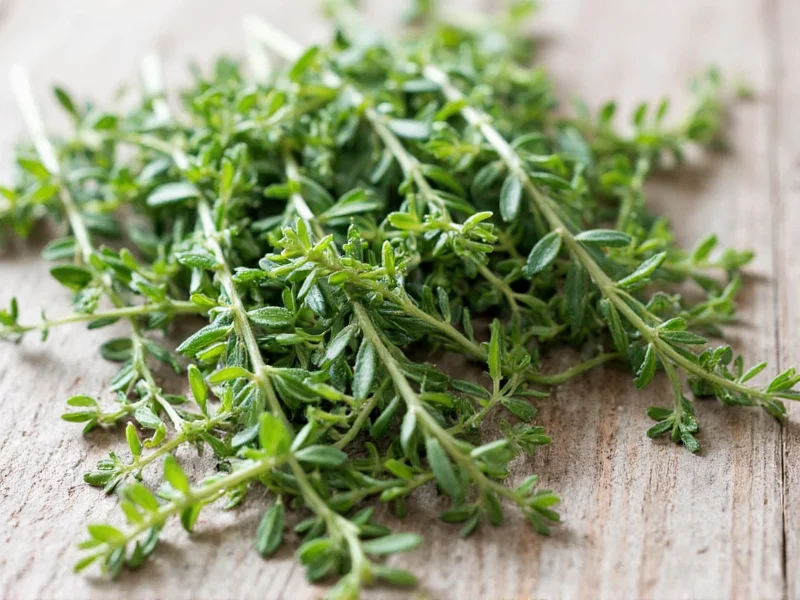Understanding how to properly substitute dried thyme for fresh thyme is essential for home cooks and professional chefs alike. When you find yourself without fresh thyme but have dried thyme available, knowing the correct conversion ensures your dishes maintain their intended flavor profile. The key difference lies in concentration—dried herbs generally contain about three times the flavor compounds per volume compared to their fresh counterparts because the drying process removes water content while preserving essential oils.
Understanding Thyme: Fresh vs. Dried
Thyme is a versatile herb used in countless culinary applications, from soups and stews to roasted meats and vegetable dishes. When substituting between fresh and dried forms, it's important to recognize their fundamental differences:
- Flavor intensity: Dried thyme has a more concentrated, earthy flavor
- Texture: Fresh thyme provides visual appeal and a subtle texture
- Storage life: Dried thyme maintains potency for 1-3 years; fresh lasts 1-2 weeks refrigerated
- Best uses: Dried works well in long-cooking dishes; fresh shines in finishing touches
Precise Conversion Measurements
While the general 1:3 ratio serves as a reliable starting point for how to substitute dried thyme for fresh thyme, specific measurements vary depending on your recipe's requirements. The following conversion chart provides exact equivalents for common cooking scenarios:
| Dried Thyme | Fresh Thyme Equivalent | Best For |
|---|---|---|
| ¼ teaspoon | ¾ teaspoon | Delicate sauces and dressings |
| ½ teaspoon | 1½ teaspoons | Marinades and rubs |
| 1 teaspoon | 1 tablespoon | Most standard recipes |
| 1½ teaspoons | 4½ teaspoons | Hearty stews and braises |
| 1 tablespoon | 3 tablespoons | Large batch cooking |
When Substitution Works Best
Not all recipes respond equally well to thyme substitution. Understanding the dried thyme to fresh thyme conversion is just the beginning—knowing when to apply it matters equally. Long-cooking dishes like soups, stews, and braises typically handle dried thyme substitution better than fresh because the extended cooking time allows dried herbs to rehydrate and release their flavors fully.
For dishes with short cooking times or those served raw, fresh thyme generally provides superior results. If you must substitute dried for fresh in these applications, consider these professional techniques:
- Steep dried thyme in warm oil or broth for 10-15 minutes before adding to dish
- Crush dried thyme between your fingers before adding to release essential oils
- Reduce the amount slightly (use 25% less than standard conversion) for delicate dishes
- Add dried thyme earlier in the cooking process than you would fresh
Common Substitution Mistakes to Avoid
Many home cooks make critical errors when attempting thyme substitution that compromise their dishes. The most frequent mistake involves using equal measurements of dried and fresh thyme, resulting in overpowering, bitter flavors. Remember that the dried thyme equivalent to fresh is always less by volume.
Another common error is substituting at the same point in the cooking process. Dried herbs generally need more time to rehydrate and release their flavors, so add them earlier than you would fresh herbs. For the best results with dried thyme instead of fresh, incorporate it during the initial cooking stages rather than as a finishing touch.
Storage Tips for Maximum Flavor Preservation
Proper storage significantly impacts how well your thyme performs in substitution scenarios. Store dried thyme in an airtight container away from light and heat to maintain potency for up to three years. Fresh thyme stays vibrant for 1-2 weeks when stored properly: wrap the stems in a slightly damp paper towel and place in a plastic bag in your refrigerator's crisper drawer.
Before using dried thyme, perform a simple freshness test: rub a small amount between your fingers and smell. If the aroma is weak or musty, it's time to replace your supply. Fresh thyme should have vibrant green leaves that don't easily fall off the stem when handled.
Recipe Application Examples
Understanding thyme substitution ratios becomes practical when applied to real cooking scenarios. Consider these common dishes and how to adjust thyme measurements accordingly:
- Beef stew: If a recipe calls for 2 tablespoons fresh thyme, use 2 teaspoons dried thyme added at the beginning of cooking
- Tomato basil soup: For 1 tablespoon fresh thyme, substitute 1 teaspoon dried thyme added during simmering
- Lemon herb roasted chicken: When replacing 3 tablespoons fresh thyme, use 1 tablespoon dried thyme mixed into the herb rub
- Vinaigrette dressing: For 1 tablespoon fresh thyme, use 1½ teaspoons dried thyme steeped in the warm oil base
Always taste and adjust seasoning before serving, as individual thyme potency can vary based on growing conditions, harvest time, and storage duration. The dried herbs conversion chart serves as a guideline, but your palate should be the final judge.
Special Considerations for Different Thyme Varieties
While common garden thyme (Thymus vulgaris) follows the standard 1:3 substitution ratio, specialty varieties may require adjustments. Lemon thyme, for instance, has a more delicate flavor profile that doesn't concentrate as intensely during drying. When substituting dried lemon thyme for fresh, use a 1:2.5 ratio instead of 1:3.
Caraway thyme and other specialty varieties similarly benefit from slight ratio adjustments based on their unique flavor compounds. When working with less common thyme varieties, start with the standard conversion but be prepared to adjust based on taste during cooking.











 浙公网安备
33010002000092号
浙公网安备
33010002000092号 浙B2-20120091-4
浙B2-20120091-4